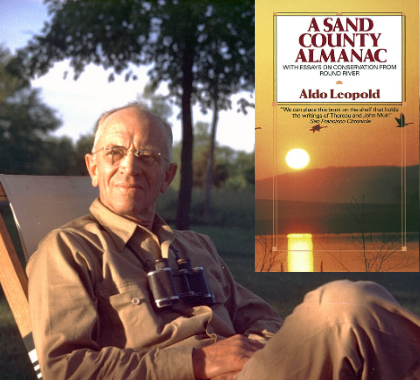I recall paging through Aldo Leopold’s A Sand County Almanac for the first time in high school, when it was called to my attention by classmates who were reading or memorizing selections for forensics contests. I read “The Land Ethic,” a chapter of the book, in the early 1990s when doing research for a book I coauthored titled Eco-Sanity: A Common-Sense Guide to Environmentalism. I didn’t actually sit down and read the book cover-to-cover until this March, when the COVID-19 shut-down prompted me to read more to fill the time.
Different editions of this book have different content and organizations. Leopold died in 1948, so two of his books, the Almanac and Round River, were edited by his son, Luna, and published in 1949 and 1953 respectively. The 1966 “expanded edition” of the Almanac, which I just read, was also edited by Luna. It combines the original Almanac with six essays from Round River. Somewhat oddly, Luna Leopold also altered the order of the final sections of the book for that edition. (More on that below.) A 2013 Leopold anthology edited by Curt Meine and published by the Library of America presents the Almanac without the 1966 changes.
The Almanac begins with 12 essays describing wildlife at the Leopold farm in central Wisconsin (north of Madison, near Wisconsin Dells) during each month of the year. Subsequent chapters describe wildlife elsewhere in Wisconsin, Illinois and Iowa, Arizona and New Mexico, Chihuahua and Sonora (two states in northern Mexico, just south of New Mexico and Texas), Oregon and Utah, and Manitoba, Canada. (The 1966 edition then has a section titled “A Taste for Country” with seven chapters.) It ends with a section titled “The Upshot” which includes “The Land Ethic” and three other brief chapters. (The 1966 edition places one of those three other chapters, “Wildlife in American Culture,” in the previous section.)
Leopold’s descriptions of wildlife at his farm are succinct, almost plain, and focus on details such as animal tracks and the songs of birds that may seem to the reader to be minor or insignificant compared, say, to the sighting of waterfalls, cliffs, and lakes. Leopold uses these details to tell stories about the landscape that are surprising, intricate, and often funny. The trail of a meadow mouse reveals the world under the cover of snow, the growth rings of an oak tree tell “the chronology of a lifetime,” pine trees engage in “much small-talk and neighborhood gossip,” and birds predict and describe and celebrate the changes of season. It’s simple and colorful, you can hear the crunch of his boot on the snow and smell the coffee in his cup.
Woven into Leopold’s narrative are stories of hunting with gun and bow and dog, of grouse, pheasants, and deer, as well as fishing and farming. Leopold clearly enjoyed hunting (“I have congenital hunting fever,” he writes) and “outdoor sports” generally, believing they helped boys develop good character and were the vehicle for introducing millions of people to wilderness. “There is value in any experience that reminds us of our dependency on the soil-plant-animal-man food chain, and of the fundamental organization of the biota.” He laments the behavior of some hunters, whom he calls trophy hunters (“the caveman reborn”) and those who hunted the passenger pigeon to extinction, and some farmers and drive-by tourists who ignore or ruin native plants, but he maintains a reservoir of understanding, sympathy, and respect for others that keeps this criticism in check.
Being a native of Wisconsin, and having returned here in my retirement, I was especially interested in Leopold’s descriptions of the farmers’ “woodlots.” They are a unique feature of the Wisconsin landscape even today as every farmer has 40 acres or so of “woods” that are maintained for “lumber, fuel, and posts” and hunting. Driving through Wisconsin, wherever you see fields of corn, soybeans, or wheat you see behind them thick stands of trees, “the back forty,” a checkerboard of agriculture and woods that is never monotonous. This is unlike neighboring Illinois and Indiana where cornfields stretch as far as the eye can see, or Michigan and Minnesota where trees are so plentiful they block your view of the landscape.
Like Henry David Thoreau’s Walden published a century earlier, Leopold’s Almanac is filled with clever insights and aphorisms. Some poke fun at politicians: “Pines,” he writes, “have earned the reputation of being ‘ever-green’ by the same device that governments use to achieve the appearance of perpetuity: overlapping terms of office.” Some aphorisms expose the follies of economists:
Every profession keeps a small herd of epithets, and needs a pasture where they may run at large. Thus economists must find free range somewhere for their pet aspersions, such as submarginality, regression, and institutional rigidity. Within the ample reaches of the Sand counties these economic terms of reproach find beneficial exercise, free pasturage, and immunity from the gadflies of critical rebuttal.
Government programs are “alphabetical uplifts gallop[ing] like forty horsemen across the Big Flats,” while the dew on lupine flowers is “unearned dividends” that cast “doubts about the real poverty of the sands.” Leopold’s commentary on hobbies, in a section titled “A Man’s Leisure Time” (one of the Round River essays) helped me to finally understand why some libertarians act the way they do. “Being serious,” he writes, “is a grievous fault in hobbyists. It is an axiom that no hobby should either seek or need rational justification.”
Beyond appreciating Leopold’s naturalist writings and clever commentary on hunters, politicians, and economists, we are told we must respect his original contribution to ethics, “The Land Ethic.” That chapter of the Almanac is brief, only about 20 pages, and makes a simple point: “The land ethic simply enlarges the boundaries of the community to include soils, waters, plants, and animals, or collectively: the land.” We should respect and protect the land as we would our fellow men and women. This new ethic is “a product of social evolution because nothing so important as an ethic is ever ‘written.'”
Leopold contrasts his ethic to the Old Testament notion that man should conquer the natural world and the economist’s view that everything of value can have a price put on it. But he is not expressly atheist: he says the amazing beauty of nature may indeed be evidence of the existence of a divine Creator; and he is not a socialist or communist: he criticizes politicians and government conservation programs and says the profit motive works well to produce whatever our ethic defines as valuable. “The existence of obligations over and above self-interest is taken for granted” for many social goods and services, he points out. He is asking only that soil and wildlife be added to that list. He concludes:
It is inconceivable to me that an ethical relation to land can exist without love, respect, and admiration for land, and a high regard for its value. By value, I of course mean something far broader than mere economic value; I mean value in the philosophical sense.
All of the Almanac to this point has been positive and pragmatic; the author seems open to compromise and debate and is often even apologetic. He understands the pioneers had to fight nature to survive and create the modern world we now take for granted, and that competing interests must be balanced. The only way to advance conservation is through education, persuasion, and widespread adoption of a new ethic. But in one of the final sections of the book, titled “Conservation Esthetic,” his tone becomes more strident as he condemns “trophy hunters,” “recreationists,” and “artificialized management of animals.” In another section titled “Wilderness“ he endorses direct action by wilderness advocates. After praising the efforts of the Wilderness Society (which he cofounded) and the Sierra Club, he writes:
It does not suffice, however, to have a few such societies, nor can one be content that Congress has enacted a bill aimed at wilderness preservation. Unless there be wilderness-minded men scattered through all the conservation bureaus, the societies may never learn of new invasions until the time for action has passed. Furthermore, a militant minority of wilderness-minded citizens must be on watch throughout the nation and vigilantly available for action.
I was very surprised to read this. “A militant minority … vigilantly available for action“? Except for the sections titled “Wilderness” and “Conservation Esthetic” (which, oddly, appear before the section titled “The Land Ethic” in the 2013 edition of the Almanac but after it in the 1966 edition) there is nothing in the Almanac or in the essays from Round River that would lead the reader to expect or embrace this call for action. In fact, militancy in support of conservation is never embraced, not even indirectly, by Leopold prior to these sections. The section titled “The Land Ethic” itself reads mostly as a pacifist’s creed.
As a libertarian, I find it significant that this strange passage that appears to advocate the use of force nevertheless repeats his warning against relying on government – the institution of society with a monopoly on the initiation of force – to protect the environment. He understood that government violence if unleashed in the name of protecting the environment is just as counterproductive as violence by individuals. The word “militant” simply doesn’t belong in this passage, or anywhere in this book. It should not be part of Aldo Leopold’s legacy.





